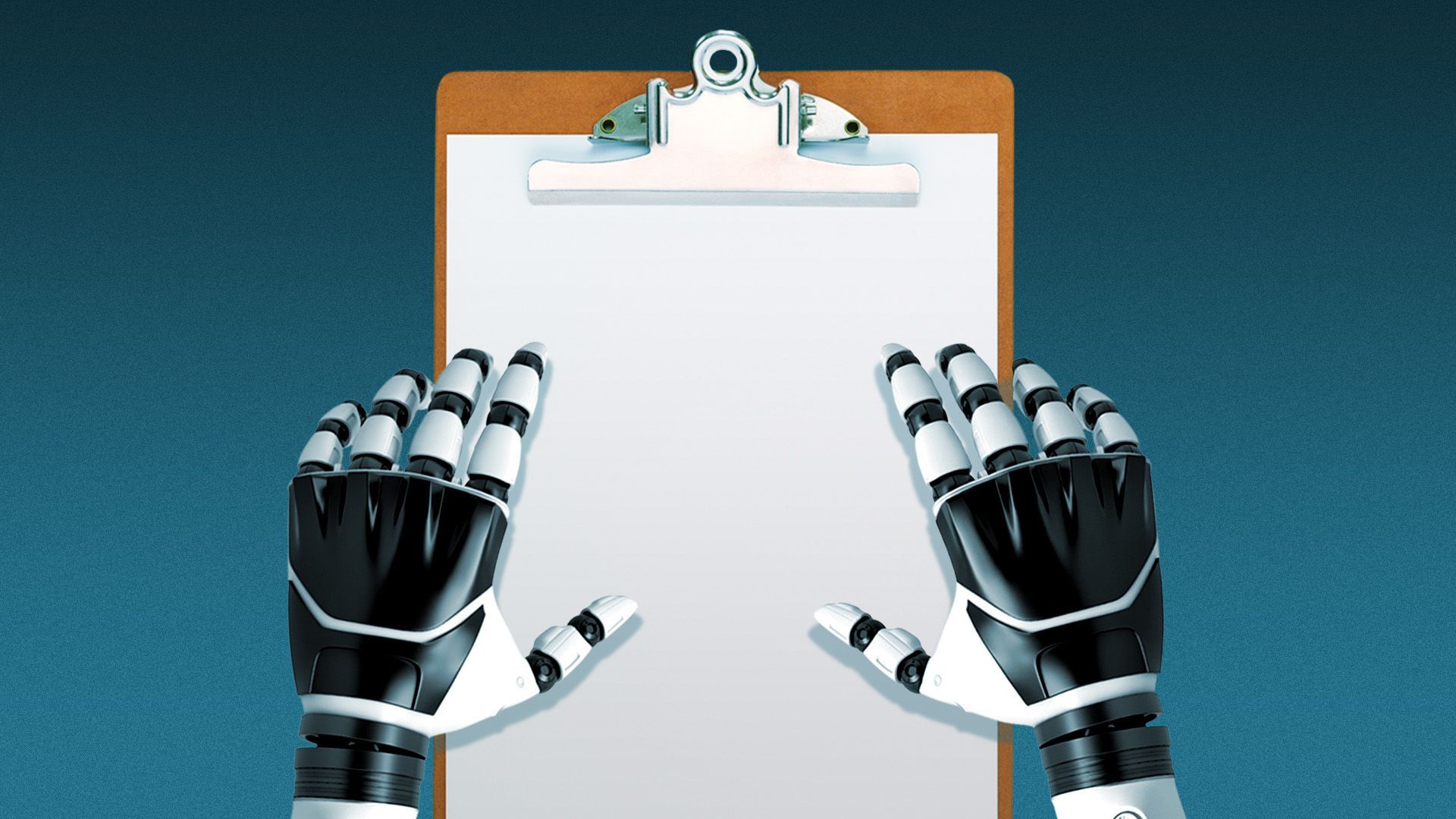| | | | | | | | | | | Axios What's Next | | By Jennifer A. Kingson, Joann Muller and Erica Pandey ·Feb 16, 2022 | | Good Wednesday morning! Looking for a new job? A robot might decide if you're the right person for the job, Joann Muller writes. - Oh, and one What's Next reader gave us an interesting take on Joann's traffic story from Monday. Maybe congestion is a good omen? Scroll down to read.
- See something cool or interesting that speaks to the way we'll live, work, play and get around in the days ahead? Take a picture for our reader photo slot. Email us at whatsnext@axios.com.
Today's Smart Brevity count: 1,089 words ... 4 minutes. | | | | | | 1 big thing: Get used to robot job interviews |  | | | Illustration: Shoshana Gordon/Axios | | | | A growing number of companies are using chat bots and AI-led video interviews to assess job candidates before a human recruiter even meets them. Why it matters: Automated interviews vastly expand the job candidate pool and are designed to ensure consistent hiring practices by rooting out ways that bias seeps into interviews, recruiters say. But job applicants complain they're dehumanizing and stressful. - For candidates, these interviews make them behave more like the faceless robots they're trying to impress — and ruin their chances of getting hired.
The big picture: Recruiters have been using artificial intelligence for a while to automate candidate searches or screen resumes, for example. - And job interviews over Zoom have become commonplace since the pandemic, with 86% of companies surveyed by Gartner saying they've used virtual technology in the hiring process.
AI-led video interviews, however, go beyond those practices because candidates are assessed by a computer algorithm. - They're evaluated not just on their answers to the interviewer's questions, but sometimes also on their facial expressions, intonation and word choice.
How it works: Caron Mitchell was recently invited to an "asynchronous video interview" for a job as a senior account manager at a tech-training startup. - There were just four questions; she had 30 seconds to read each question and two minutes to answer. While some companies allow do-overs, her prospective employer did not.
The whole process was unnerving and demoralizing, she tells Axios. - "You're at a tremendous disadvantage as a candidate when it's a one-way street," she said. "I'm used to reading people, and there was nothing there for me to read."
Mitchell has no idea how she was assessed, whether anyone in HR saw her interview, or whether it was the algorithm that rejected her. AI systems are also vulnerable to bias because data used to train prediction models may be limited, or because they reflect the biases of humans involved in training them. - In 2018, Amazon abandoned a computer program that used machine learning to score job applicants after developers realized that the tool discriminated against female candidates.
The other side: "Everything is moving to chat," Kevin Parker, ex-CEO and now adviser at HireVue, a leading video interview company, tells Axios. - Someone looking for a new job might scan a QR code on a hiring poster Saturday night, kicking off a chatbot conversation about their experience and an invitation to apply with a video interview on Sunday.
- "You can complete the entire application process before work starts Monday morning — all while your interest is high."
Read the full story |     | | | | | | 2. Child care squeeze fuels Great Resignation |  | | | Illustration: Sarah Grillo/Axios | | | | There's a gender gap in the Great Resignation, with women quitting their jobs at higher rates than men, Erica Pandey writes. Between the lines: That gender gap is widest in the states with the most child care disruptions, according to a new report from the payroll company Gusto. The big picture: Nationally, 4.1% of women quit their jobs in January, compared with 3.4% of men — a 0.7 percentage point difference. - But in Maine and Rhode Island — where around 45% of families reported COVID-related child care disruptions in the Census Household Pulse Survey — the gender gap swelled to 1.7 percentage points, Gusto found.
- At the same time, in Missouri and Arizona — where less than 25% of households said child care was disrupted — the gender gap was close to zero.
What's happening: As we've reported, women are far likelier than men to take on additional tasks like child care and housework while working from home. These burdens have pushed mothers across America out of the workforce. - Now, as Omicron cases fall, schools are reopening. But many child care centers have closed down due to COVID pressures, like staff shortages and lockdowns. And the availability of affordable, high-quality child care remains a growing problem.
The bottom line: Employers will have to beef up child care benefits to draw scores of parents — especially mothers — back to work. |     | | | | | | 3. Why your rent is going up |  "Oh my yes!" That's what real estate consultant John Affleck told Axios' Emily Peck when she asked if rent increases like the ones in the chart above were unusual. State of play: From 2015-2019, the average annual rent growth across major markets was 3.5% — but in 2021 it was 13%, said Affleck, senior vice president of research at John Burns Real Estate Consulting. - And in some Florida cities it was as high as 30% or more.
Meanwhile, a measure of rent prices in the Consumer Price Index, released last week, showed rents up 3.8% in 2021. That's higher than the historical average, but certainly nowhere near those other numbers. Why it matters: Rising rents are part of the story on inflation and the housing crunch. They're particularly painful for Americans already devoting a large part of their income to housing. Read the rest |     | | | | | | A message from Axios | | The AI-powered tool transforming communications | | |  | | | | Axios HQ is an easy-to-use tool helping 200+ organizations communicate with more clarity and efficiency. Get an inside look — at the tool, templates, and AI-powered tech — that help companies like Edelman and Takeda keep stakeholders informed and productive. | | | | | | 4. What you're saying: Reader feedback |  Data: TomTom Traffic Index 2021; Chart: Jacque Schrag/Axios Joann's story on how the pandemic changed rush hour traffic patterns used data from the "TomTom Traffic Index," which relies on "hundreds of millions of anonymized GPS signals from cars and smartphones around the world to analyze traffic in more than 400 cities." - Peter Harnik — a former New Yorker who now lives in D.C. — decided that TomTom's findings amounted to an apt metaphor for the desirability of various metropolises.
- "Even though TomTom was apparently developed as a metric to chastise cities for the frustration caused by their traffic delays, it actually seems like an excellent way of judging the desirability and even 'excellence' of different cities," Harnik wrote.
- "No longer must we suffer through the tedium of comparing the many lists of 'best city for food,' 'best city for music,' 'best city for museums,' 'best city for shopping' — we can just roll together all the factors by using TomTom as a composite index."
- "It turns out that 'congested' may be a synonym for 'great'," he says.
|     | | | | | | 5. 1 💤 thing: Bigger beds are in | | When it comes to getting their beauty sleep, Americans want more space, Erica writes. What's happening: Demand for king beds outpaced demand for every other size during the pandemic, the Wall Street Journal reports, citing the International Sleep Products Association. - Queen beds are still the most popular, but the prevalence of king beds is growing quickly.
The pandemic could be a contributing factor. - People are craving space after two years stuck at home with family and pets.
- Tempur Sealy International told the Journal that king-size beds account for half of its mattress sales, up from 40% in pre-COVID times.
Fun fact: The popularity of bigger beds is a relatively recent trend. It wasn't under 1999 that queen beds became the leading size. |     | | | | | | A message from Axios | | The AI-powered tool transforming communications | | |  | | | | Axios HQ is an easy-to-use tool helping 200+ organizations communicate with more clarity and efficiency. Get an inside look — at the tool, templates, and AI-powered tech — that help companies like Edelman and Takeda keep stakeholders informed and productive. | | | | Was this email forwarded to you? Get your daily dose of What's Next magic by signing up for our free newsletter here. |  | Bring the strength of Smart Brevity® to your team — more effective communications, powered by Axios HQ. | | | | | | Axios thanks our partners for supporting our newsletters. If you're interested in advertising, learn more here.
Sponsorship has no influence on editorial content. Axios, 3100 Clarendon Blvd, Suite 1300, Arlington VA 22201 | | | You received this email because you signed up for newsletters from Axios.
Change your preferences or unsubscribe here. | | | Was this email forwarded to you?
Sign up now to get Axios in your inbox. | | | | Follow Axios on social media:    | | | | | |
No comments:
Post a Comment